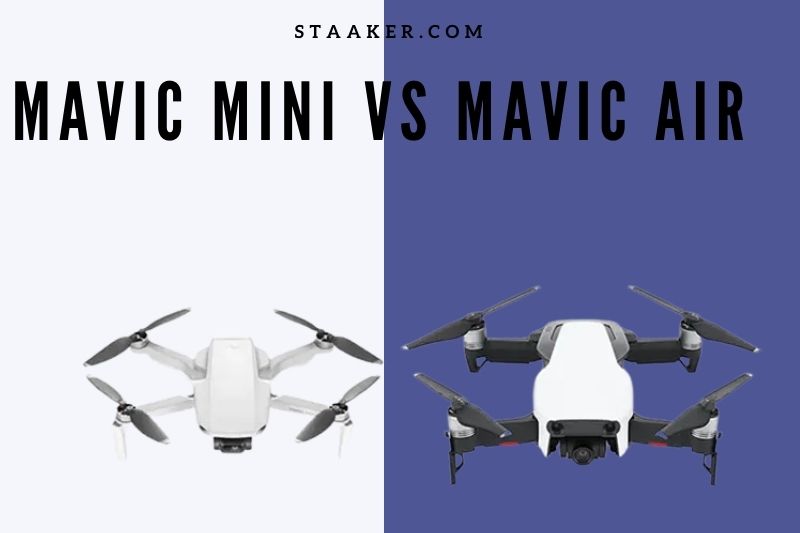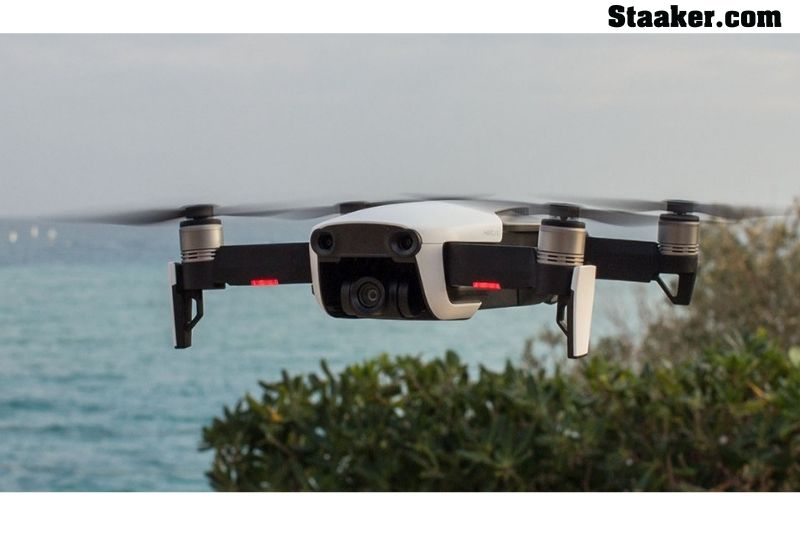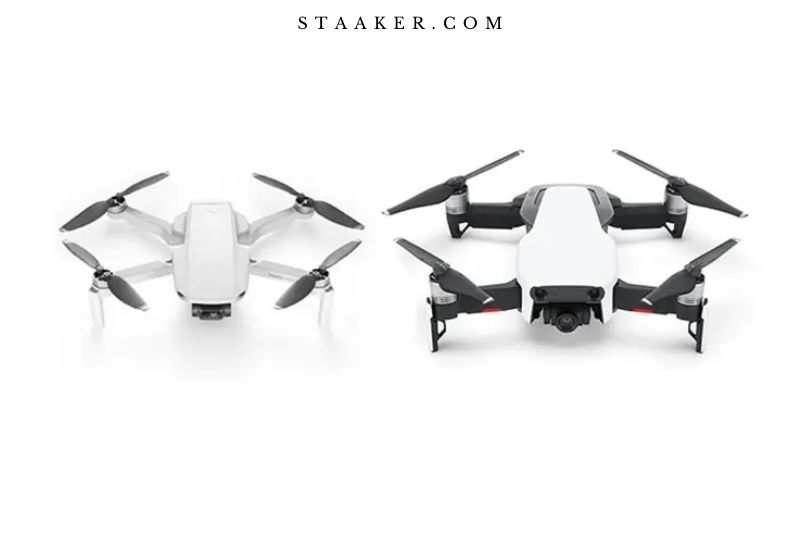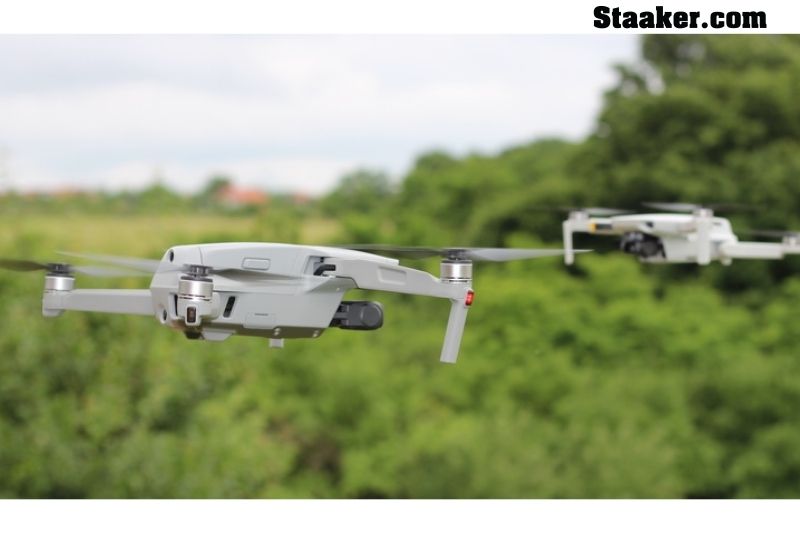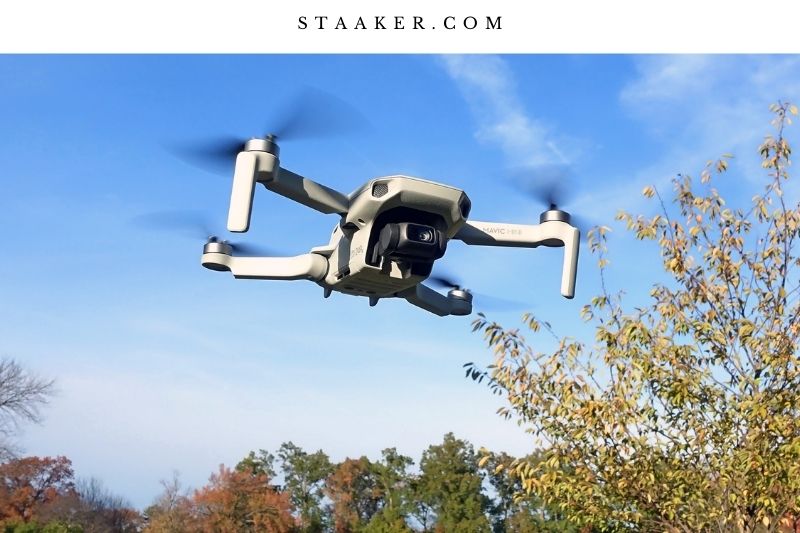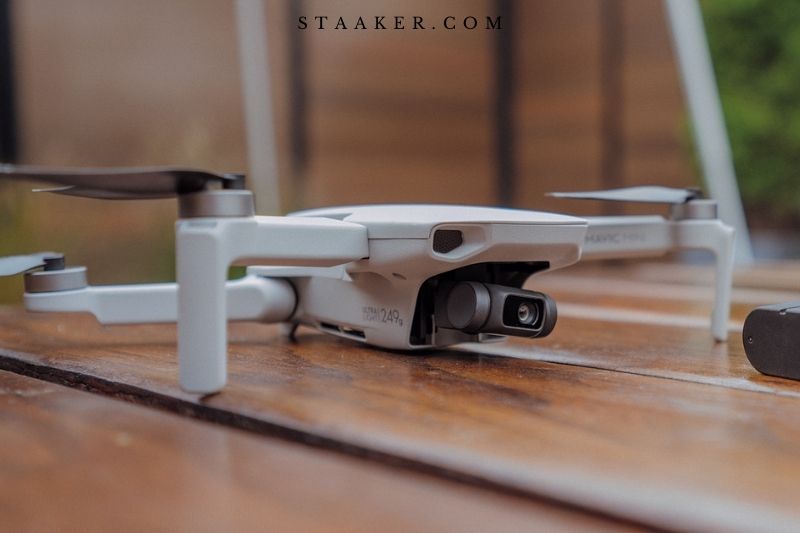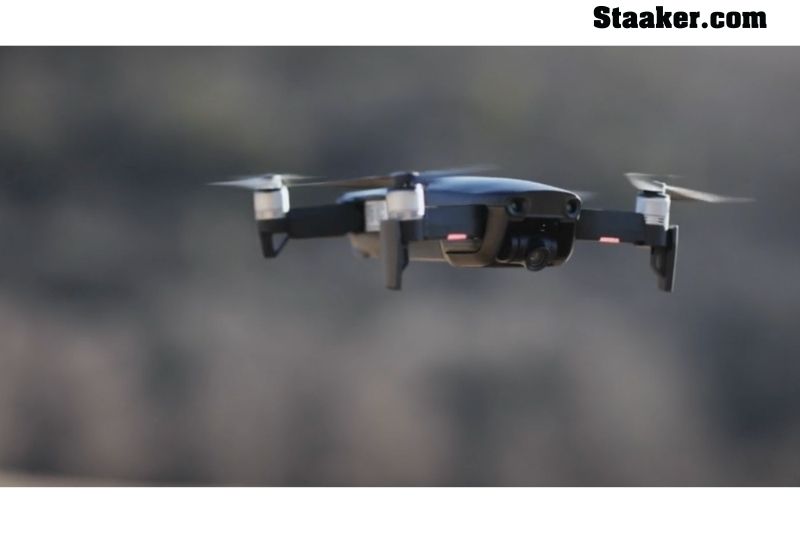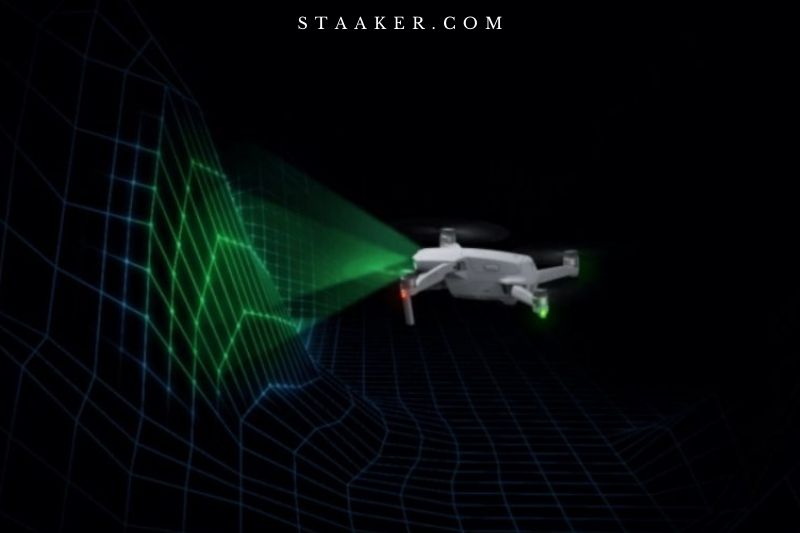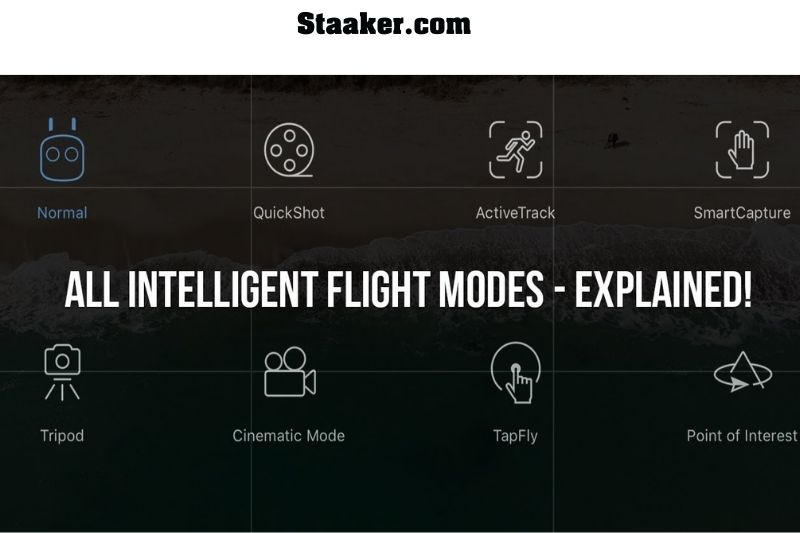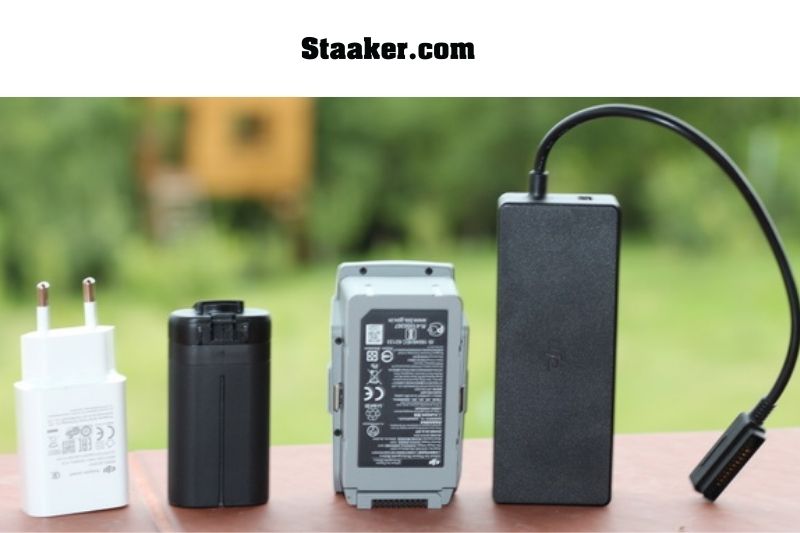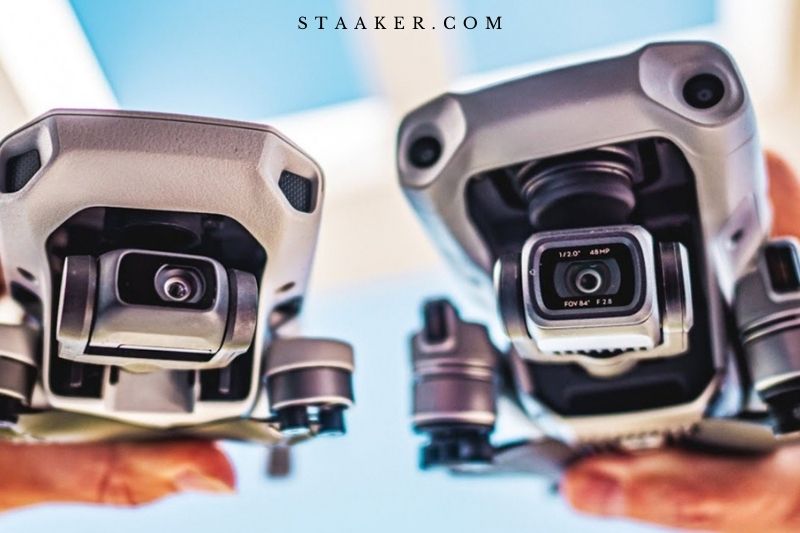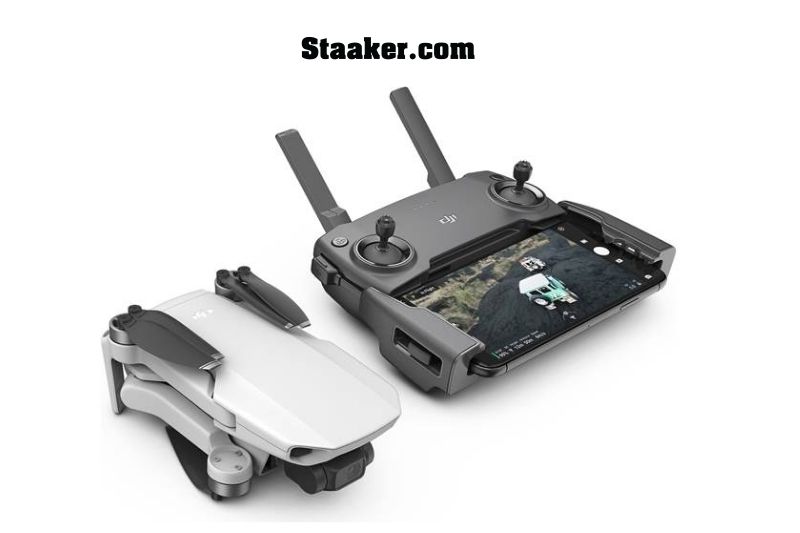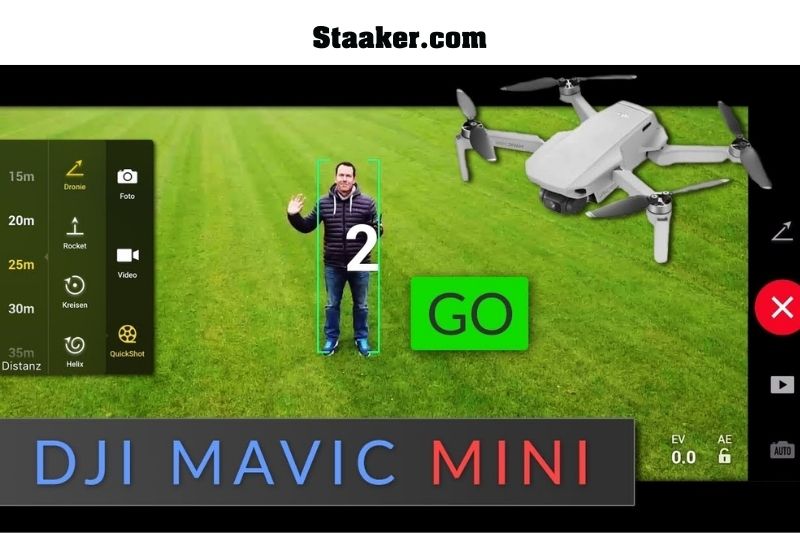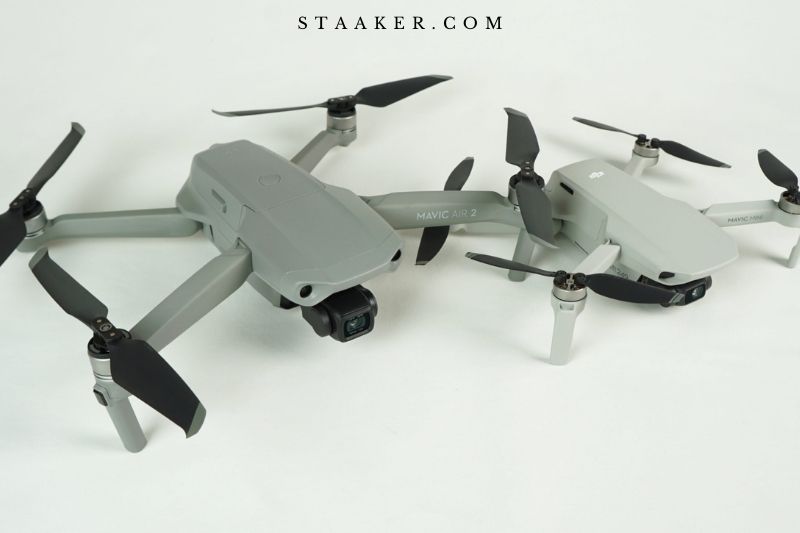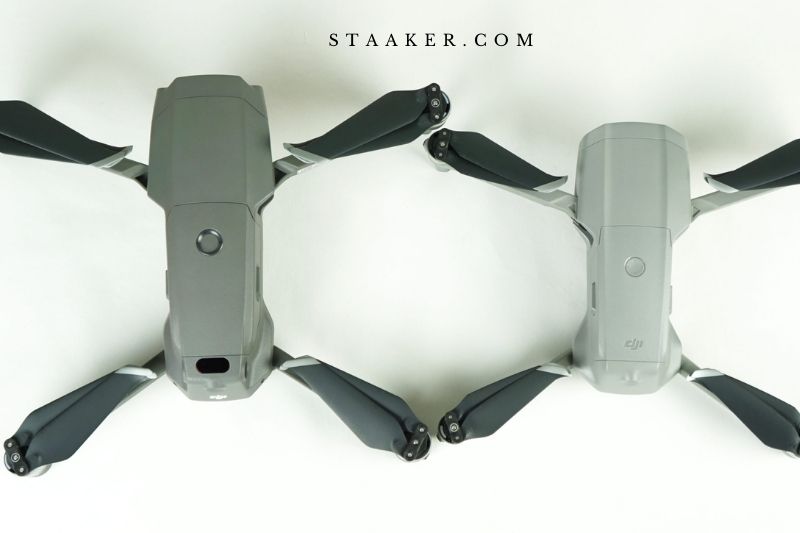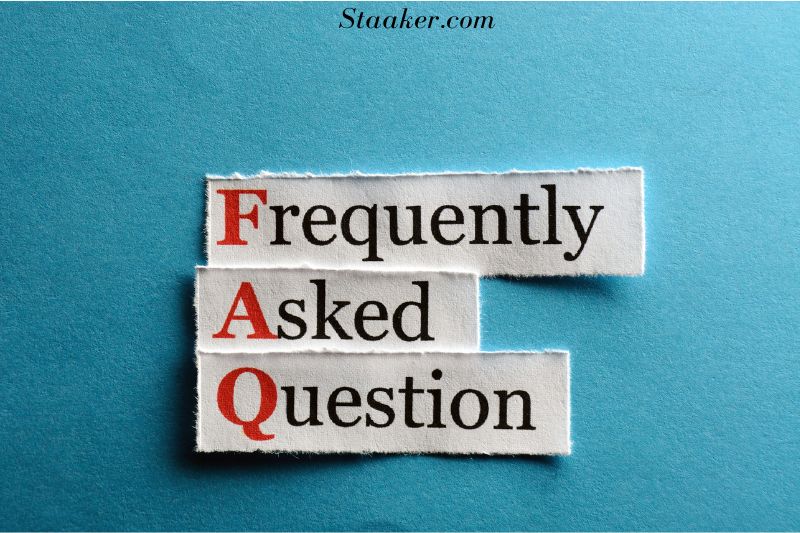The Mavic Mini and the Mavic Air are great drones for aerial photography and videography. They both have unique features that make them stand out from each other. The Mavic Mini is the lighter and more portable option, while the Mavic Air has a longer flight time and a higher quality camera.
In this article below, let’s explore some of the key differences between these two drones: Mavic Mini vs Mavic Air.
DJI Mavic Mini vs Mavic Air
DJI Mavic Air
- Mavic Air, a small drone by DJI, can record a 4K video for $919.
- Although the Air can be flown using the DJI app on a tablet or smartphone, the controller provides greater range and speed.
- Air utilizes the smartphone as a controller, and the controller has a range of up to 3.2 miles.
- The controller uses your smartphone to display what the drone’s camera sees as you fly.
- The highest speed of the Air is 42.5 miles per hour. It also features forward and reverses obstacle avoidance to prevent collisions.
- As is the case with all Mavic Series drones, they can be folded up for portability. When extended for flight, the drone’s dimensions are 6.61 by 7.24 by 2.50 inches. It measures 6.61 3.26 1.92 inches when folded.
- It weighs less than one pound (1.16 ounces) and has a flight time of 21 minutes.
- Video Resolution: 4K Ultra HD: 3840×2160 24/25/30p 2.7K: 2720×1530 24/25/30/48/50/60p
DJI Mavic Mini
- The Mavic Mini was released by DJI in October of 2019.
- The Mini weighs only 8.78 ounces or 249 grams, which is a big amount.
- FAA registration is required for drones weighing more than 250 grams. Drones weighing less than 250g that are flown for recreational purposes do not need to be registered. Nonetheless, you must adhere to drone legislation.
- When folded, the Mini measures 6.29 7.95 2.16 inches. The Mini’s folded dimensions are 5.513.222.24 inches. This is small enough to fit in the palm of your hand.
- As you may expect, the Mini is not as well-equipped as the Air.
- It is impossible to reduce the price by $500 without removing some items.
- The Mini’s camera can record 2.7K videos, while the Air’s camera can only shoot 4K videos. Both drones create incredible videos.
- With the DJI Fly app’s numerous movie templates, users can create incredible videos with just a few taps. This application is ideal for users with little editing skills, as it provides creative choices for transforming any video into a shareable clip.
- Video Resolution: 2.7 K: 2720×1530 25/30 p
The DJI Mavic Mini lacks forward and reverse obstacle avoidance. The Mini is equipped with downward obstacle detection, which will inform you if it detects an unsafe landing place. Additionally, it stabilizes hovering via downward sensing.
The Mini cannot be controlled by a smartphone. The controller for the Mini must be connected to a smartphone or tablet.
Unobstructed, the Mavic Mini’s range is up to 2.4 miles. When the drone was within a metropolis with several buildings and trees, the controller had difficulty attaching to it. Flying above White Rock Lake increased my range, allowing me to travel beyond two miles.
Mavic drones are equipped with GPS and a home-return function. This will allow you to return your drone home with a single button click.
Mavic drones will return home if they fly too far, lose connection for more than 20 seconds, or their batteries are critically low.
The camera on the Mini is mounted on a three-axis mechanical gimbal. This assures the stability of the video. Amazingly, despite being buffeted by wind, the drone provides footage that appears to have been taken with a tripod.
The Mini has three flight modes: Speed (the fastest mode), place (the regular mode), and Cinematic (a slow, deliberate maneuvering mode that is ideal for smooth video productions).
Pros And Cons
Mavic Mini
PROS
- Entry is inexpensive.
- The remote control is offered.
- Exceptional battery life.
- Sharp 2.7K video and 12 MP images
- Gimbal stabilization.
- Automated camera movements for moviemaking
- Utilize the Find My Drone function.
- Lacks a requirement for federal registration.
- Simple to use drone
CONS
- Testing could have connectivity issues.
- Omits obstacle detecting sensors.
- There is no 24fps video option.
- Not compatible with HDR or RAW pictures
Mavic Air
PROS
- Extremely little.
- 4K Ultra HD video with a high bit rate.
- Panorama and HDR still capture.
- Raw and JPEG file formats are supported.
- Asteroid video recording.
- It is feasible to circumvent obstructions.
- Intelligent flight modes
- 12 MP image
CONS
- Charging through USB is not supported.
- No 4K DCI video.
- Panorama stitching is a laborious process.
- The flight takes roughly 18 minutes in reality.
Design
Mavic Mini from DJI is the lightest at 249 grams. The Mavic Mini folds to 140x82x57mm (LxWxH) and unfolds to 160x202x55mm (LxWxH). The Mavic Mini folds quickly and fits in the palm of your hand. The Mavic Mini is a tiny version of the Mavic 2 with a light-grey matte finish. Mavic Mini is the lightest drone in its class.
The Mavic Mini’s primary benefit is its low weight. It fits into the most prevalent weight category for drones in the majority of nations. DJI is pleased that Mavic Mini can now be flown by drone enthusiasts without limits or regulations.
Additionally, it is foldable and can be folded down to the size of a smartphone. In terms of size, the drone weighs 430 grams. It is intermediate between the Mavic Mini 2 and the Mavic 2. The drone has an industrial appearance and is offered in black, white, or red. The front of the drone will be raised approximately one inch by a short, foldable leg extension that can be folded up.
Gimbal & Camera Performance
The compact DJI Mavic Mini is equipped with a powerful camera capable of capturing breathtaking aerial images. Using a 1/2.3-inch sensor, the Mavic Mini can record 2,7k video at 30 frames per second and 12-megapixel stills.
The Mavic Mini lacks 4k capabilities, but its camera is ideal for everyday use. Additionally, it features a 3-axis gimbal that offers stable, smooth filming. The DJI Mavic Mini cannot shoot MP4 or JPEG files for professionals.
DJI Mavic Air is equipped with a 3-axis stabilized gimbal system that enables smooth, shake-free video capture. Additionally, it can record 4k video at 30 frames per second. A 1/2.3 CMOS sensor can record 12-megapixel still images.
It offers greater formatting options and can shoot in both JPEG and DNG RAW formats. The strong camera of the Mavic Air can be utilized by both semi-professional and recreational users.
Depending on what you intend to do with your camera, you can select the appropriate sort of camera drone.
If you want to take a wonderful photo or record a great movie, you can get the Mavic 2 Zoom with its high-quality camera. It is capable of recording 4K video at 30 frames per second and 12 MP stills.
The zoom capabilities of the drone enable it to capture unusual shooting settings, such as Super Resolution. This enables the drone to take 48-megapixel photographs. The Dolly Zoom The cinematic effect of a subject being zoomed in on distorts its background.
Mavic Mini vs Mavic Air: Performance in Flight
Mavic Mini
- 30 minutes maximum flight time at 14 km/h in calm conditions
- Maximum Wind Resistance: 28.8 kilometers per hour
- Maximum speed (no wind, near sea level):
- 13 m/s (S-Mode)
- Distance: Maximum 4 kilometers
- Video Transmission System: wifi Plus
- Temperature Range: 0°C to 40°C
- Mavic Air’s flight performance is safe and dependable because of its forward, rearward, and downward dual-vision sensors.
- Sensors for obstacles are a great feature.
Mavic Air
- Flight Duration: 21 minutes (at a consistent 25 kph)
- Maximum Wind Resistance: 29-38 km per hour
- Maximum speed (no wind, near sea level):
- 68.4 km/h (S-mode[1]).
- Distance: Maximum 4 kilometers
- Video Transmission System: wifi Plus
- Temperature Range: 0°C to 40°C
Despite being small and lightweight, the DJI Mini is powerful and boasts excellent flight performance. Due to its lightweight construction, the Mavic Mini has a maximum flight time of 30 minutes and a maximum range of 4 kilometers.
To guarantee stable communications and prevent interference, the drone employs a wifi system with enhanced capabilities. It oscillates between 2.4 and 5.8 GHz. The drone is compact and lightweight enough to fit in your pocket.
It can still withstand wind rates of 28.4 kilometers per hour under warranty, which is yet another feat for best DJI drone. It is incredibly stable and accurate in flight, making it simple for inexperienced pilots to use.
There are three flying modes on the Mini: Speed (the fastest mode), place (the usual mode), and Cinematic (a slow, deliberate maneuvering mode that is great for smooth video productions).
The Mavic Air has the same range as the Mavic Mini, but with a shorter flying time and a range of 4 kilometers and 20 minutes, it is more efficient. The Mavic Air employs a wifi transmission mechanism that can oscillate between 2.4GHz and 5.8GHz to maintain good connections. The Mavic Air is larger than the Mavic Mini and can endure winds between 29 and 38 kilometers per hour.
Mavic Air, a compact and lightweight drone, provides great flight performance for both novice and expert users. This drone is perfect for travelers because its superior flight performance enables limitless possibilities.
Obstacle Avoidance Systems
- No Obstacle Avoidance Systems on Mavic Mini
- Front, bottom, and rear Obstacle Avoidance Sensing on the Mavic Air
Compared to Mavic Air, Mavic Mini lacks a system of obstacle sensors. The Mavic Mini is the only drone with an inbuilt GPS and downward-facing vision sensors. Even though it lacks an obstacle avoidance system, the drone’s airborne accuracy and precision make it quite easy to pilot. Pilots who fly safely and incident-free should experience safe flights.
To boost safety, you can mount propeller guards to the Mavic Mini. However, this will add 249g to the drone’s weight. When flying with propeller guards, pilots must have a license.
In Japan, where drone restrictions are more stringent than in the United States, DJI is able to offer a 199g version because a significant portion of the weight is in the battery.
Mavic Air has a system for avoiding obstacles with forward-, downward-, and rearward-facing sensors. The clever obstacles avoidance feature of Mavic Air makes it easy to avoid obstacles and detects them faster.
The Advanced Pilot Assistance System of the Mavic Air will scan the environment for obstacles. It will detect impediments and automatically select the best route to avoid them. If it cannot locate a target, it will stop and hover in position.
Intelligent Flight Modes
The Mavic Air and Mavic Mini are the Mavic drones with the most sophisticated flight modes, which include:
Return-to-Home, CineMode, QuickShot Modes: Dronie, Circle, Helix, and Rocket are available on the Mavic mini.
Mavic Air features ActiveTrack and SmartCapture, as well as TapFly. Tripod Mode, Cinematic Mode. The focus of attention Rapid-fire modes. Circle, Helix. Dronie. Rocket. Asteroid. Boomerang.
Mavic Mini offers the fewest intelligent flight options of all Mavic models. Return-To-Home, CineSmooth mode, and four QuickShot options, including Dronie (Circle), Helix, and Dronie (Circle), are available on the Mavic Mini (and Rocket).
QuickShots enables users to capture spectacular and dynamic footage rapidly. CineSmooth Mode makes the Mavic Mini’s movement and speeds more fluid. ActiveTrack, one of the most popular intelligent flight modes found on DJI drones, is absent from the Mavic Mini, which is a notable omission.
The drone may return to the identical location from whence it was released by pressing a button or when it detects a low battery or weak signal. ActiveTrack is a popular flight option for DJI drones that is absent from the Mavic Mini. This mode and other of DJI’s most popular modes, such as TapFly, may be added to the Mavic Mini in future updates.
Mavic Air features all of DJI’s most popular flying modes, including TapFly, Cinematic Mode, Point of Interest, ActiveTrack, and TapFly. QuickShot modes such as Dronie, Circle and Rocket, Helix, and Boomerang are also available. The Mavic Air provides a vast selection of sophisticated modes that enable users to create and enhance cinematic pictures.
Mavic Mini vs Mavic Air- Battery life
The Mini’s battery capacity is 2,400mAh. Maximum flight time of up to 30 minutes, depending on the climate. This was roughly appropriate, although flying in Sports mode can reduce flight time by a few minutes.
The Mavic Air, on the other hand, has a foldable design and a battery that provides up to 21 minutes of flight time
Mavic Mini vs Mavic Air- Remote Control
Mavic Air
With the controller, the Mavic Air’s communication range is limited to four kilometers or two and a half miles. This is considerably smaller than the Pro’s range of seven kilometers (4.3 miles), which is significantly greater.
Some individuals were afraid that this news might harm the drone’s connection. During our testing of three drones on three continents, we did not observe any signal drops. However, if Mavic Air is pushed beyond its limitations, video feed interruptions may occur.
The Mavic Air, like the Mavic Pro, has a 3-axis gimbal. However, it has been redesigned to increase the drone’s stability. While side-to-side panning with the gimbal is simple, moving the camera up or down can be somewhat choppy.
By switching to Cinematic Mode in the app, you can maintain your film smoothly. This mode slows the drone and reduces braking in order to produce smoother video. However, even this requires a great deal of practice to obtain a stable image.
Additionally, you can monitor up to 16 patients simultaneously. ActiveTrack allowed our DJI Mavic Air evaluation unit to track six subjects independently. You can use all of them or just one as your focal point to switch to QuickShot mode.
SmartCapture is fantastic, but new QuickShot technologies named Asteroid and Boomerang make it even more entertaining. An asteroid, Boomerang, and Spark feature QuickShot settings that are older. They create short videos with a central subject. Using the application requires only a few taps.
The first method combines many shots into a 10-second blip that begins with the subject and ends with a spherical, bird’s-eye view of the place. Boomerang is a drone that completes a 360-degree circuit and then returns to its original place after circling the subject.
Mini Mavic
Unlike other versions, the DJI Mavic Mini’s controller does not feature a screen. Instead, it can accommodate both Android and iOS smartphones. The joysticks are screwed into the body so that it falls flat and unfolds to create a classic feel.
The micro USB port on the left side of the controller connects and charges your phone. The drone is also available with Lightning, micro USB, and USB-C cords. Thus, any smartphone compatible with the DJI Mavic Air Mini Fly app is supported.
The jog dial at the top of the camera rotates the controller 90 degrees vertically so that it can gaze forward to the bottom. It cannot look upwards like Anafi the Parrot. However, its range is average for drones in general. The L trigger begins video recording, and the R trigger captures a photo, which is ideal when operating the drone while wearing gloves.
It is difficult to organize the flying experience. You must connect the remote control to your mobile device, attach the joysticks, and launch the application. This requires roughly one minute. The experience is portable and compact, and the controller and drone are collapsible. However, the flight feels solid and natural.
After it was connected, we were able to pair the drone with all of our iPhones. We tested it with Android 9-10 and iPhone devices.
- Read more: How To Charge Dji Mavic Mini Controller
App
With a few clicks, the DJI fly app enables users to make incredible videos using a variety of templates. The DJI fly app is ideal for individuals with limited editing skills. It provides alternatives for transforming any video into a shared clip ( for Mavic Mini).
- If you want to more choices, see this guide:Best Drone app
Pricing
Mavic Air is priced at about $900 and comes with one battery, a controller, and a carrying case.
The cheap “Fly More” bundle from DJI includes two additional batteries, a charging hub, and a travel case for your drone.
This package contains two more batteries, additional propellers with screw-on heads, a hub for charging the battery, propeller guards, and a travel bag.
Purchase the Fly More Kit to cut costs on drones. It is beneficial to purchase extra batteries.
The Mavic drones are among the most enjoyable activities I’ve ever engaged in. On rainy weekends, I would wake up regretting that I couldn’t fly. My wife was annoyed that I took it on walks and picnics, but she asked me to fly it eventually.
The Mini is the ideal first drone for someone who is interested in learning to fly.
It is easy to understand why drones like the Mavic Air are so costly. These drones can perform rigorous tasks. Video of high quality can be utilized in television and film projects. They could also assist law enforcement in locating missing persons.
Video
Verdict: DJI Mavic Mini Vs Mavic Air
Price: The DJ Mavic Mini is significantly less expensive than the Mavic Air.
Mavic Mini carries 249 grams compared to 430 grams for the Mavic Air.
Mavic Mini’s flight time is 30 minutes, whereas Mavic Air’s flight time is 21 minutes. Mini wins.
The Air’s top speed is 42,5 mph, while the Mini’s is only 29 mph. Mavic Air won.
Both drones have a maximum range of 2.48 miles, but the DJI Mavic Air has a superior connection and wins this round.
The DJI Mavic Air had forward, rearward, and downward sensors for obstacle avoidance. However, the Mini has only downward sensors to assist in landing. Mavic Air is the clear winner.
Both cameras have 24mm lenses in 35mm format equivalent; hence this is a tie.
Options for camera quality and frame rate include 1/2.3-inch CMOS sensors on both drones. Mavic Air has superior specifications. However, this Mavic Mini is excellent and produces images that are clearer and cleaner. Additionally, it has a really impressive dynamic range.
Even though the Mavic Air shoots at 100 Mbps compared to the Mini’s 40 Mbps, the Mavic Mini wins this match.
The DJI Mavic Air easily wins in windy circumstances.
- Controls for the camera: a sketch.
- Exposure settings: Likewise, this is a tie. The drones are distinct, with the Mini providing fewer options but still delivering.
- Construction quality: the Mavic Air is clearly superior
- The Mavic Mini is quieter than the Air at 74 decibels against 79 decibels.
- The DJI Mavic Air has 8GB of internal storage and hence wins. The Mini lacks any.
Surprisingly, the Mavic Mini also demonstrates superior low-light performance.
The Mavic Mini is one of the smallest and lightest drones on the market, while the Mavic Air is a bit larger and heavier. Both drones are easy to fly and have excellent flight time and range. The Mavic Mini is better for beginners, while the Mavic Air is better for more experienced pilots.
FAQs
Which Is Better: DJI Mavic Air vs DJI Mavic mini 2?
New users and pros looking for an excellent mix between price, size, performance, and simplicity will be drawn to the all-new DJI Mavic Air 2’s funding design. For consumers searching for a drone that can record 4K footage and has more contemporary options, the DJI Air 2 is a capable model.
Can Mavic Air be used at night?
Can a drone be flown at night? Quite simply, you can.
Is Mavic Air suitable for novices?
The Mavic Air 2 is an incredibly adaptable piece of equipment that is ideal for both experienced drone hobbyists looking for an all-around solid product and newbies just entering the hobby.
When it rains, can Mavic fly?
Can a Mavic Pro be flown in the rain? Flying a Mavic Pro in the rain is not recommended as it will negatively impact the drone’s longevity and operation. However, customers might be able to operate a Mavic Pro in the rain if they have wet suits that cover every part of the device.

